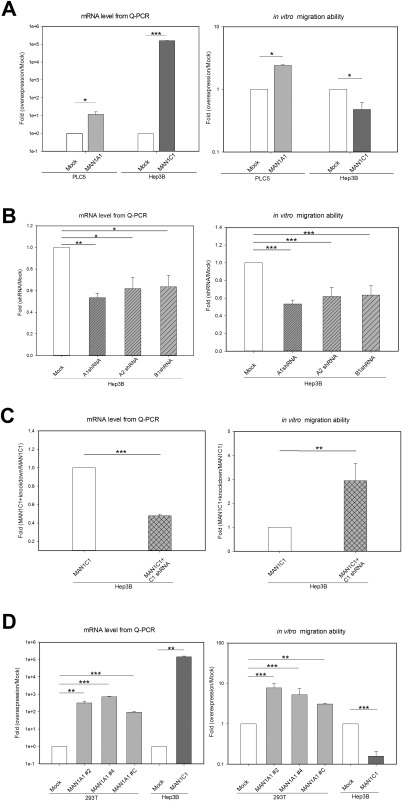Figure 2.

MAN1A1 enhances and MAN1C1 decreases the migration ability of cells in vitro. (A) Left: qPCR result of the mRNA level for transient overexpression of MAN1A1 and MAN1C1. Right: In vitro migration ability of MAN1A1‐ and MAN1C1‐overexpressing cells. The overexpression of MAN1A1 in PLC5 cells enhanced their migration ability compared to the DsRed vector control (Mock). In contrast, the overexpression of MAN1C1 in Hep3B cells decreased their migration ability compared to the mock control. (B) Left: qPCR result of mRNA levels following shRNA knockdown of MAN1A1, MAN1A2, and MAN1B1 individually. Right: In vitro migration ability as decreased on knockdown of MAN1A1, MAN1A2, and MAN1B1 in Hep3B cells. (C) Left: qPCR result of mRNA levels following overexpression of MAN1C1 and then shRNA knockdown of MAN1C1. Right: In vitro migration ability as increased on knockdown of MAN1C1 in Hep3B cells with overexpressing MAN1C1. (D) Left: Stable overexpression of MAN1A1 and MAN1C1 increased the mRNA level as measured by qPCR. Right: In vitro migration ability of the stable cell line showed that overexpression of MAN1A1 in 293T cells significantly enhanced their migration ability compared to the DsRed vector control (Mock). In contrast, the stable overexpression of MAN1C1 in Hep3B cells dramatically decreased their migration ability compared to the mock control. All experiments were repeated in triplicate. Statistical significance was calculated using the Student t test (*P < 0.05, **P < 0.01, ***P < 0.001).
